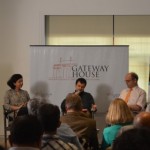Maritime history teaches us that history is not “event based”, in fact when viewed from the sea, history reveals ‘linkages’ and ‘circulations’ between geographical regions that one never knew existed.
One of several examples that were discussed at a recent panel discussion hosted by Gateway House along with Avid Learning and the U.S. Conulate in Mumbai was the linkage between two contemporaneous ancient civilisations – the Indus Valley and the Mesopotamian civilisation. The former was based in the river valley of the Indus River and its tributaries, and the latter in the river valley of the Tigris and the Euphrates (in present day Iraq).
Both these civilisations were urban societies that prospered due to the annual flooding of their rivers that deposited rich alluvial silt on its banks, which made agriculture flourish. However, most would not be aware that there was an active sea trade between both these complex urban civilisations that extended from the mouth of the River Indus to the Persian Gulf.
These sea routes that date back over 5000 years are the earliest known maritime trade routes in the Indian Ocean.
In further reiterating the importance of the Seas (including rivers) as conduits for trade, migrations, culture, religion, contagion, explorations and conquest, Maritime Historian Lincoln Paine spoke about the explorations of the Norsemen (Vikings) from the Scandinavian countries of present day Sweden, Denmark, and Norway.
Sometime during 700 AD to 1100 AD, the Vikings travelled on the mighty rivers of Europe (then unexplored), that resulted in connecting the Baltic Sea to the Black Sea. This brought them into contact with people from the Eurasian landmass and with the trading worlds of the Mediterranean and the Indian Ocean.
However, the best preserved written records of maritime trade in the Mediterranean Sea and Indian Ocean (stretching from the Coast of East Africa to South East Asia), are the Cairo Genizah Records. These are letters written by sea-faring Jewish merchants from 900 AD to 1800 AD, which survived the vagaries of time largely because they were disposed off in a Genizah (a store room in a Jewish Synagogue).
What these Hebrew letters, written in Judeo-Arabic, exemplified was a very cosmopolitan and global world of sea-farers, merchants, mendicants, who travelled across the seas to port cities of the Mediterranean and the Indian Ocean. More importantly, the early letters throw light on the medieval port cities of India (like Mangalore) and the lives of these merchants on the Sub-continent.
The fact that the language used in these letters is Hebrew, but written in the Judeo-Arabic script, in itself highlights the inherent cosmopolitanism in a sea-faring world.
Extenuating this point in another direction, cultural theorist, Ranjit Hoskote brought in the idea of cosmopolitanism vis-a-vis ‘cultural interiority’ (or boundaries proscribed by religion and community), and how merchants had to draw a fine balance between the two.
This was exemplified by this author, who spoke about the legendary Bombay merchant David Sassoon’s son, Elias, who was posted in Shanghai for 14 years soon after the opening of China in the aftermath of the First Opium War (1839-42). Elias sailed for China, taking his shochet (a Jewish person trained in the ritual slaughter of certain mammals and birds for food) with him. This ensured that the orthodox Elias could observe the tenets of his religion in (then) remote Shanghai, but it did not necessarily mean that he shut himself away from fellow merchants and the local Chinese.
The Dominance of Western Historiography
Another interesting facet of the conversation was brought up by Paine, when he talked about what inspired him to write the encyclopaedic “The Sea & Civilisation” (2013). For one, it addressed a lacuna in his earlier book (“Ships of the World”) with regard to the deep and rich maritime history of South and South East Asia. Very few ships from the Indian Ocean (with a few exceptions) were covered, largely because of the absence of archival material, so plentiful since the middle ages for European ships.
This required recourse to the study of ethnographic, religious (the Gita), and literary sources (Arthashashtra, Manusmriti) for references to ship-building, sea-faring communities, and the rules and laws that governed navigation of the seas. According to Paine, these varied sources give an insight to the early beginnings of maritime law, as we know it today.
In the final count, this nuanced engagement with the past will result in an honest and holistic approach not just to the study and understanding of world history, but also local histories.
Sifra Lentin is the Mumbai History Fellow at Gateway House.
This blog was exclusively written for Gateway House: Indian Council on Global Relations. You can read more exclusive features here.
For interview requests with the author, or for permission to republish, please contact outreach@gatewayhouse.in.
© Copyright 2016 Gateway House: Indian Council on Global Relations. All rights reserved. Any unauthorized copying or reproduction is strictly prohibited.


